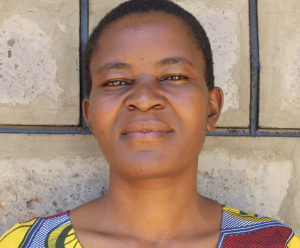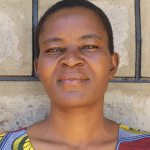May, 2021: Isikhi Primary School Project Complete!
Isikhi Primary School in Kenya now has access to a new source of safe, clean water thanks to the completion of their rain tank, which can collect 75,000 liters of water! We installed new latrines and handwashing stations for students, and we trained the school on improved sanitation and hygiene practices, including COVID-19 prevention. These components work together to unlock the opportunity for these students to live better, healthier lives.

Students make a splash to celebrate the completed rain tank.
"My life is going to change because I will never suffer from waterborne diseases, and I shall be healthy. I shall never be absent because I have clean and safe water for drinking," said student Ronaldo.
"This water point will enable us to practice farming, even during the dry season, and we shall sell vegetables to our teachers and earn some money, which we will use to buy enough textbooks, and the performance will improve."

Teachers were just as excited as the students about the new rain tank on campus.
"My life is going to change because having safe and clean water for drinking is going to reduce waterborne diseases, and I am going to be healthy. Money that was used for medication is going to be diverted to businesses. This water point will enable us to maintain cleanliness at school. Also, the hygiene standards are going to improve, and this will change the face of the school," said teacher Seth Amboso.

Teacher Seth Amboso takes a drink from the rain tank.
How We Go From Ground to Rain Tank
Construction for this 75,000-liter rain tank was successful!
Parents, staff, and students helped our artisans gather everything needed for construction. The school’s kitchen staff and a few parents helped provide meals for the artisans, while the school provided the artisans’ accommodations. Local women and men helped our artisans with their manual labor, too.

Students and teachers help deliver materials to the construction site.
The process officially began with our staff and school administration looking around the school compound to determine the best location for a new rain tank. This needed to be the best site with enough land and a nearby building with good, clean roofing to catch the rainwater.

Excavated rain tank site
Then, we cleared the site by excavating the soil to make level ground for the tank foundation. We cast the foundation by laying big stones on the level ground and reinforcing them using steel wire, concrete, and waterproof cement. We affixed both the drawing pipe and the drainage pipe as we laid the foundation.

Laying the foundation
Next, we formed the walls using a skeleton of rebar and wire mesh with sugar sacks temporarily tied to the outside as backing. We attached this to the foundation’s edges so that the work team could start the Ferro-cementing process. They began layering the walls with cement, alternating with the inner and outer side until six cement layers were in place. (The sugar sacks are removed once the interior receives its first two layers of cement.)

Students help deliver water for construction and assist with the wire wall's placement.
Inside the tank, we cast one central and four support pillars to ensure the dome does not cave in once cemented. Meanwhile, we plastered the inner wall while roughcasting the outer walls. We dug and plastered the access area to the tap outside the tank, installing a short staircase. In front of the access area, we constructed a soak pit where spilled water can drain from the access area through the ground. The pit helps to keep the tap area dry and tidy.

Interior plasterwork
Dome construction could begin after the tank walls settled. We attached a dome skeleton of rebar, wire mesh, and sugar sacks to the tank walls before cementing and plastering it using similar techniques as the wall construction. We included a small manhole cover into the dome to allow access for future cleanings and water treatments.

Dome work
We propped long wooden poles (about 75 of them!) inside the tank to support the dome while it cured. Then it was down to the finishing touches: fitting a lockable cover over the tap area, affixing the gutters to the roof and tank, and setting an overflow pipe in place at the edge of the dome for when the tank reaches capacity.

Affixing the gutters
Once finished, we gave the rain tank three to four weeks to undergo complete curing. Finally, we removed the interior support poles and dome sugar sacks and cleaned the tank.
We officially handed over the rain tank to the school directly following the training. Students and staff celebrated the presence of clean water on campus. The event was an excellent chance for us to acknowledge the school administration and students as the primary parties entrusted with the tools we have given and remind them of our continued support as they develop. Happiness, thanksgiving, and appreciation were the order of the day flowing in all directions.

Complete rain tank
VIP Latrines
This project funded the installation of six new ventilated improved pit (VIP) latrines. Instead of an even split, the school decided to allocate four latrines to the girls and two for the boys to match the girls' greater need for the new facilities.

Girls pose in front of their new latrines.
These new latrines have cement floors designed to be easy to use and clean, locking doors for safety and privacy, and vents designed to keep air flowing up and out through the roof. With a rain tank right on school property, there should be enough water to keep them clean.

Boys pose in front of their new latrines.
Handwashing Stations
The two handwashing stations were set up during training and handed over to the student health club. These were placed outside of the girls’ and boys’ latrines to encourage handwashing after latrine use. Health club members will teach other students how to wash their hands at the stations properly, make sure the stations are filled with water, and ensure that there is always a cleaning agent such as soap or ash available.

Students demonstrate handwashing using a new station at training.
New Knowledge
We scheduled hygiene and sanitation training with the school’s staff, who ensured that the training date would be convenient for pupils and teachers. When the training day arrived, facilitators Rose Serete and Valiant Sachita deployed to the site to lead the event. 17 pupils attended the training, which we held outside the classroom but under the shade of a mango tree where there was plenty of fresh air. We observed physical distancing, and the place was conducive to learning.

Pupils practice physical distancing.
We focused on COVID-19 prevention, transmission, and symptoms while also covering several other topics. These included personal hygiene such as bathing, oral hygiene, the ten steps of handwashing; environmental hygiene; child rights, operation and maintenance of the rain tank, latrines, handwashing stations, and leadership and governance. During the latter, the students elected their peers to lead their newly formed student health club.

Dental hygiene demonstration
The club will be significantly involved in the water, sanitation, and hygiene project management at school. It will encourage good health and hygiene practices amongst their peers, teachers, and the larger community. We involved stretches, dances, and physical activities between each topic to keep the pupils’ energy up and their minds active. By the end of the training, each pupil understood their role in sustaining clean water and good health within their school community.

Training in session
The most memorable topic was addressing myths and rumors about COVID-19. One pupil who raised her hand said that COVID-19 was a curse from God, at which the whole group of students laughed at her. According to her church, the pupil insisted that it was true, but the facilitator addressed this myth, explaining more about what the virus is and how it came to spread around the world. The second most memorable topic was how to sneeze and cough using the elbow. When the facilitator called upon one pupil to demonstrate, he raised his hands and sneezed in the air. This made people laugh, but the facilitator corrected him and showed him the best way to cough.

Brillian, elected Chair of the student health club
"The training was very valuable. I have learned a lot, like how to wash hands and brush teeth, and as the leader of the child health club, I am going to teach others about this new knowledge," said pupil Brillian, the club's elected Chair.
"The training was very important because I have known the ten handwashing steps and dental hygiene, which I am going to practice both at school and home," said Braving, a member of the club.
We asked Braving what it was like to be at home for most of the last year due to Kenya's national coronavirus-related school closures and what it has been like coming back to school.

Braving
"When the school closed due to COVID-19, I was affected. I could not remember whatever I had learned earlier, and I was not able to learn because my fellow students were learning online, and my parents did not have a smartphone, so I lost a lot. While school was closed, I missed learning programs, co-curriculum activities, and my friends at school. I am feeling better to be in school with my friends and continuing with the syllabus."

"Yes, I have worried because of the rate at which people are dying, and it is because of ignorance, but if we follow the rules and regulations, all shall be well," Braving said, adding that learning the ten steps of handwashing was the most valuable thing he learned that day.

When an issue arises concerning the water project, the students and teachers are equipped with the necessary skills to rectify the problem and ensure the water point works appropriately. However, if the issue is beyond their capabilities, they can contact our field officers to assist them. Also, we will continue to offer them unmatchable support as a part of our ongoing monitoring and maintenance program.
Thank you for making all of this possible!


 Rainwater Catchment
Rainwater Catchment
 Rehabilitation Project
Rehabilitation Project














































